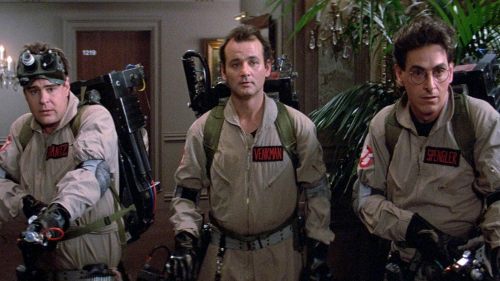Collins’ Crypt: The Awkward Charms Of CURTAINS
As of this writing, Rogue One sits at #7 on the (non-inflated) highest grossing films of all time in the US, and was generally well-liked by moviegoers and critics, so it's hard to argue against the decision to rework large chunks of the film with a different director. If the movie turned out disastrous and/or flopped, sure, we could argue that they ruined it and that we deserve to see the original version and yadda yadda, but sometimes, it seems as though the producers' instincts - the sort of thing that made them successful producers to begin with - are correct, even if it's hard to say so aloud. And it's not like this sort of thing had never happened before; it's rare to see on something as big as Star Wars, of course, but it happens fairly often, particularly in the horror genre. Producers want scares that they can market, but some directors want to believe they're making something classier than a generic horror movie and do their best to avoid them, opting to claim they are making a "psychological thriller" and have no need for such nonsense. The producer(s) will then find someone who WILL put those things into the movie, and years later we get a fascinating special edition blu-ray about the whole affair.
This is what happened with Curtains, a Canadian slasher thriller that was originally directed by Richard Ciupka, a cinematographer making his feature debut. After the bulk of the production had finished, producer Peter Simpson was unhappy with his less-slasher-y approach to the material and demanded heavy reshoots, resulting in Ciupka taking his name off the film (Simpson himself called the shots for the new material). The resulting film was credited to "Jonathan Stryker" - the name of the film's lead male character, a pretentious (and horny) director played by the great John Vernon in one of his most asshole-y asshole roles ever, and if you think the resulting movie would be a bit of a mess, you'd be... very much correct. It's not incoherent like certain Dimension products have turned out, but the tone of the two productions (extensive enough that two separate crews are credited at the end, split by "Act I" and "Act II" headers) is so different that one can spot the new scenes even if they weren't aware of the production history.
(Spoilers for this relatively obscure film are ahead, so proceed with caution!)
For example, most of the movie takes place in an isolated house, and the kills that occur there are very much in the thriller vein (Vernon's character is merely shot to death by a spurned lover), but the two big slasher-movie type chases do not feature the location at all. And the funny thing is, those two chases are pretty much the highlights of the film, and the first - an ice skating chase/kill - is easily the film's most nightmare-inducing image. The plot concerns director Stryker (Vernon) having six actresses come to his home in order to audition for the role of "Audra" in his next picture, and in between scenes of him bedding them, someone in a hag mask is offing them one by one. Like many a Canadian slasher of the era it's a whodunit, as we're not sure who is wearing the mask, and I must be honest the reveal actually surprised me the first time around. But the lack of backstories for the characters and the reshooting/re-editing (and even recasting, in one case) limits the audience's ability to put much of the mystery together for themselves, and it's not exactly airtight as a result. Plus, it starts off with a lengthy sequence in an asylum that Samantha Eggar's character got herself thrown into so she could research a role, and the section lasts so long that you might be tempted to think the entire movie would take place there. Then we get our first actress kill scene, which has its own lengthy diversion (a rape fantasy she has arranged with her boyfriend) that further delays the beginning of the actual plot.

However, I think that wooziness is precisely why the film has endured to the degree that it has, instead of being forgotten about and relegated to budget packs for eternity (rather than being cleaned up and special edition-ed by the good folks at Synapse a while back). The reason I think that ice skating scene - which really isn't all that special as far as these things go - left such a scar on many a young horror fan who caught it on late night TV is because the film is so "off" and even hard to explain in full, much like an actual nightmare. There's a doll who appears in nightmares and real-life scenes alike, only to be dropped from the proceedings without its significance ever being explained. Eggar's asylum sequence has lots of unnecessary "crazy lady does something wacky" moments, which have nothing to do with anything and would be hard to recall came from this particular film if they were half-remembered years later (why would anyone associate an asylum with this storyline?) Then there's a character named Matthew who is just THERE, never really speaking and not serving any known purpose, but he's too vague to be a red herring (time has probably made him more suspicious, since the character is played by a very young Michael Wincott, long before his "typecast as a bad guy" days), which just adds to the murkiness.
Speaking of Wincott's character, his death is probably the most baffling thing about the movie. Originally, he was supposed to get killed on his snowmobile, which would then crash through a window, but Simpson and his editor decided the scene - and that death - wasn't working. So instead his body was found in a pool later with no explanation, but they didn't let the crash footage go to waste. At one point in the film, two characters upstairs are shot and fall out of the window they're standing next to, so the editor decided to combine the footage of them falling out their window (where they originally just landed on the ground below, like gravity would dictate) with a snippet of the snowmobile crashing through the one below, making it seem like it's their bodies that are crashing through that second window. It is a remarkable betrayal of everything we know about physics and the laws of motion, but I swear it almost works since Vernon and Wincott are both wearing dark clothing and the editor cuts to a reaction of one of the actresses before we can really say "Hey that's not a person, that's a snowmobile!" (it was probably even easier to fool people who saw it on murky/cropped VHS).
Movies like this are the ones that are easiest to half-remember and then have vivid nightmares about (or, again, late night viewing memories). When you can process everything, it's a lot easier to keep the images from searing into your head as something like this can, where the lack of answers forces your brain into coming up with its own explanations. And the movie's under-the-radar status (its distribution was just as troubled as the production, apparently) helps too, as someone will vaguely remember "an old lady ice skating with a sickle?" and be met with blank stares since no one else had seen it. So when you do find it, it's like a little gift. Plus it offers peace of mind that the movie actually existed and wasn't just some vague nightmare you had. And the movie wouldn't have that appeal going for it had Ciupka's vision been fully realized, because literally everything people remember was something from Simpson's reshoot, with the possible exception of the ending. The original ending was reworked slightly (basically a new location), but Lynne Griffin (better known as Clare from Black Christmas, cast as one of the leads here) says Ciupka was the one who directed it, not Simpson, and I couldn't find anyone refuting it other than the general belief that Simpson was behind all of the new footage. Either way it's a pretty creepy and almost depressing note to go out on, with her character in an asylum, clinging to her dreams of stardom while "performing" for the various patients in her ward, before the title finally makes sense and a pair of curtains close over the image.

It's not hard to see what kind of movie Ciupka was making, with the actresses messing with each others' heads and the killer opting for a more subtle approach. One of his death scenes seemingly remains fully intact - the ballerina who is dancing in her room as the camera slowly zooms into just her face, at which point she is knifed. It's a fairly effective scene and not at all slasher-y (though I can't quite tell where the killer came from without the victim seeing him/her), and would even be fine as a change of pace for your standard lumbering boogeyman (indeed, Violet's death in F13: A New Beginning is basically the Danny Steinmann-ized version of the same thing), but in his version that'd be as horrific as it got, which is not what Simpson wanted (and, to be fair, Simpson said right up front he wanted a slasher film). I wouldn't be opposed to watching his version, if such a thing exists (Simpson and the editor have both said that Ciupka only shot about 50 minutes of usable footage), but I have little doubt that the messy, half-slasher version is the superior one.
To be fair, I think anything can be improved with a slasher chase, but even a slasher critic would have to agree that the big chase at the end of the film is one of the best from that era. Following in the steps of Prom Night (which had a number of the same crew, including Simpson), there's an epic cat and mouse sequence that ends in death, as opposed to saving such theatrics for the Final Girl, an archetype this movie doesn't really have. In Prom Night it was Jamie Lee Curtis' friend Wendy who got the honor, dodging the killer throughout the halls of their high school for a solid six or seven minutes only to meet her demise anyway, and here it's Tara, played by Sandee Currie (better known to horror fans as Mitchy in Terror Train). After being scared by the aforementioned gravity-defying bodies coming through the window, she screams and runs off to a prop house that we've never seen before or will again (again, reshoots!), so even when the killer isn't around we get freaky visuals of mannequins and masks hanging around, giving it a vague Tourist Trap feel. Then the killer chases her in there and we get the good stuff that Ciupka's version never would have offered, and like Prom Night we aren't yet certain that this girl will be killed, making it more suspenseful than a traditional Final Girl chase can usually offer.
I first saw this one at an all-nighter back in 2012, where the late hour (after midnight anyway) coupled with the slow pace made it a bit rough for me - I actually stayed awake, if memory serves, but walked away thinking it was too slow for its own good. But since I collect all the slashers from that era I ended up getting Synapse's Blu-ray a couple years later, and finally gave it a second look this past week. Fully awake this time, I realized that the slowness is actually part of its charm, and while it's not a full blown slasher (by design!), those elements work better than they do in many films that were designed that way from the beginning. So yeah, it's half melodrama, but that's part of what makes it memorable, and thus earns its place in the very wonky crop of 1983 body count flicks, nearly all of which are more than a bit strange in one way or another (it's the same year that gave us Disconnected, Sledgehammer, and the immortal Blood Beat, not to mention Sleepaway Camp). On the Blu-ray, nearly everyone interviewed seems to think that the movie is dogshit, but take my word for it over theirs: there aren't many slasher films like it, and you shouldn't let their overworked efforts (the film ultimately took three years to finish) be in vain.



